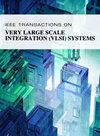低功耗和高速SRAM单元与双节点破坏自恢复可靠的应用
IF 2.8
2区 工程技术
Q2 COMPUTER SCIENCE, HARDWARE & ARCHITECTURE
IEEE Transactions on Very Large Scale Integration (VLSI) Systems
Pub Date : 2024-10-03
DOI:10.1109/TVLSI.2024.3466897
引用次数: 0
摘要
由于CMOS技术的不断进步,晶体管的尺寸和间距不断减小。静态随机存取存储器(SRAM)单元中敏感节点的电荷逐渐减少,使得SRAM单元对软错误越来越敏感,如单节点扰动(snu)和双节点扰动(dnu)。因此,本文提出了两种类型的抗辐射SRAM单元。首先,提出了一种低功耗DNU自恢复S6P8N电池。该单元可以实现所有敏感节点的SNU自恢复,也可以实现部分dnu自恢复,且功耗低。其次,我们提出了一种高速DNU自恢复S8P6N电池,它具有类似于S6P8N的软容错水平。此外,它还减少了读访问时间(RAT)和写访问时间(WAT)。仿真结果表明,所提出的细胞对所有snu和大多数dnu具有自恢复能力。与RHD12、QCCM12T、QUCCE12T、RHMD10T、SEA14T、RHM- 12t、S4P8N、S8P4N、RH-14T、HRLP16T、CC18T、RHM相比,S6P8N的平均功耗降低48.78%,平均WAT降低6.62%。而S8P6N的平均功耗降低23.64%,平均WAT和RAT分别降低9.07%和36.84%。本文章由计算机程序翻译,如有差异,请以英文原文为准。
Low-Power and High-Speed SRAM Cells With Double-Node Upset Self-Recovery for Reliable Applications
Transistor sizing and spacing are constantly decreasing due to the continuous advancement of CMOS technology. The charge of the sensitive nodes in the static random access memory (SRAM) cell gradually decreases, making the SRAM cell more and more sensitive to soft errors, such as single-node upsets (SNUs) and double-node upsets (DNUs). Therefore, two types of radiation-hardened SRAM cells are proposed in this article. First, a low-power DNU self-recovery S6P8N cell is proposed. This cell can realize SNU self-recovery from all sensitive nodes as well as realize partial DNUs self-recovery and has low-power consumption overhead. Second, we propose a high-speed DNU self-recovery S8P6N cell, which has a soft-error tolerance level similar to the S6P8N. Furthermore, it reduces the read access time (RAT) and write access time (WAT). Simulation results show that the proposed cells are self-recovery for all SNUs and most of DNUs. Compared with RHD12, QCCM12T, QUCCE12T, RHMD10T, SEA14T, RHM-12T, S4P8N, S8P4N, RH-14T, HRLP16T, CC18T, and RHM, the average power consumption of S6P8N is reduced by 48.78%, and the average WAT is reduced by 6.62%. While the average power consumption of S8P6N is reduced by 23.64%, and the average WAT and RAT by 9.07% and 36.84%, respectively.
求助全文
通过发布文献求助,成功后即可免费获取论文全文。
去求助
来源期刊
CiteScore
6.40
自引率
7.10%
发文量
187
审稿时长
3.6 months
期刊介绍:
The IEEE Transactions on VLSI Systems is published as a monthly journal under the co-sponsorship of the IEEE Circuits and Systems Society, the IEEE Computer Society, and the IEEE Solid-State Circuits Society.
Design and realization of microelectronic systems using VLSI/ULSI technologies require close collaboration among scientists and engineers in the fields of systems architecture, logic and circuit design, chips and wafer fabrication, packaging, testing and systems applications. Generation of specifications, design and verification must be performed at all abstraction levels, including the system, register-transfer, logic, circuit, transistor and process levels.
To address this critical area through a common forum, the IEEE Transactions on VLSI Systems have been founded. The editorial board, consisting of international experts, invites original papers which emphasize and merit the novel systems integration aspects of microelectronic systems including interactions among systems design and partitioning, logic and memory design, digital and analog circuit design, layout synthesis, CAD tools, chips and wafer fabrication, testing and packaging, and systems level qualification. Thus, the coverage of these Transactions will focus on VLSI/ULSI microelectronic systems integration.

 求助内容:
求助内容: 应助结果提醒方式:
应助结果提醒方式:


